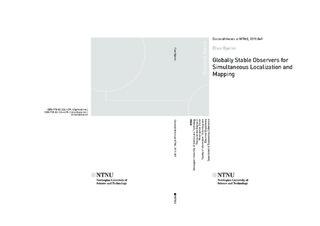| dc.description.abstract | This thesis focuses on developing observers that can be applied to simultaneous localization and mapping (SLAM), with an emphasis on developing observers that has theoretical proof of convergence. The motivation for this research has been to develop robust navigation methods, that can apply information from the surroundings through on-board sensors, mainly cameras. Applying nonlinear system theory, all the observers have proof of semi global or global asymptotic stability; while globally exponential stability and exponential stability in the large is also shown for some of the observers.
Conversely to the main practice in the literature, the observers have been designed on the bearing measurements being represented as unit vector measurements. Two different techniques are applied in the design of the observers or filters. The first technique was based on having an attitude heading reference system available and rearrange the system as a linear time varying system. Astandard Kalman filter could thus be used, and globally exponential stability achieved. A setup where the Kalman filter was combined with a nonlinear observer was also tested, and the combination was able to improve both the accuracy and robustness of the filtering.
The second design method, utilized the kinematics of the unit vector pointing at landmarks, and filtered directly the bearing measurements. Inspired by the literature on nonlinear observers, the cross product was used as an innovation term involving the bearing vectors. This proved to give the observer semi-global stability. Through the filtering, it was proved that gyro bias and distance to the landmark could be estimated separately, with the same semi global asymptotic stability, and exponential stability in the large.
The fact that the observer designed around unit vector measurements also opened other applications which are highly relevant to visual navigation. A well known fact when performing navigation only based on camera, is that the depth of the scene is ambiguous. This means that all the structure from motion that is estimated from the camera is relative, in fact, the absolute depth in the scene or scale between the camera and real world is unobservable without external information. By normalizing the velocity measured by the camera, similar kinematics as used for the landmark measurements could be applied, and by assuming that a self calibrating IMU with gravity estimate was available, the observer could fuse normalized velocity with the sensor values from the IMU and estimate the metric velocity of the vehicle. This setup also worked with other observers and filters from the literature, and a thorough comparative study was made in simulations and with experimental data, confirming that the velocity estimation was possible.
Finally, an observer was expanded to estimate both distance to the landmark and gyro bias simultaneously. With the same global asymptotic stability and exponentially stability in the large. With verifiable conditions for convergence. This made it possible to apply a camera to both gyro bias estimation and estimating distance to the landmark without dealing with problems of initialization or divergence. The setupwas verified both in simulations and on a UAV flight experiment, where the combination of a GNSS, IMU and camera, could perform estimationboth of gyro bias and depth in the camera. Further it was shown how headingand altitude could be estimated or derived from the measurements, such that with the sensor setup proposed, both an altimeter and magnetometer were redundant sensors.
There is somework left to prove that camera navigation based on the presented observers is feasible in closed loop or in an industrial setting. Never the less, the thesis has been able to address two important topics in camera aided navigation, namely having a observer using monocular camera handling gyro-bias, and having a setup for velocity estimation provided only a monocular camera and a tactical self calibrating IMU; all with proof of semi-global stability. | |
